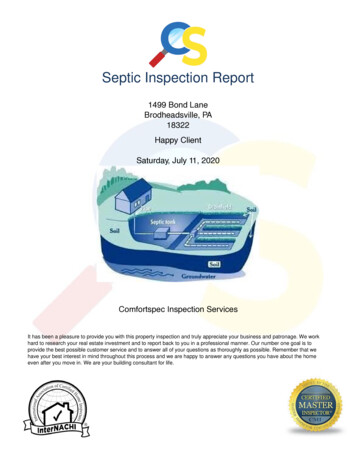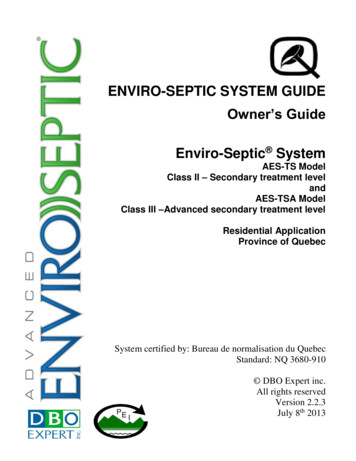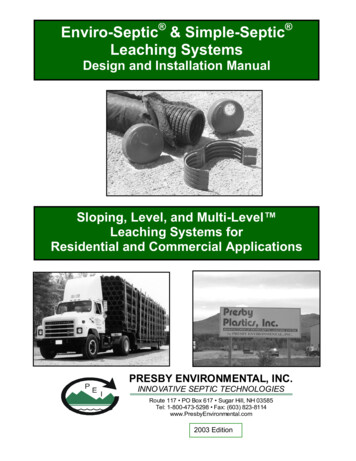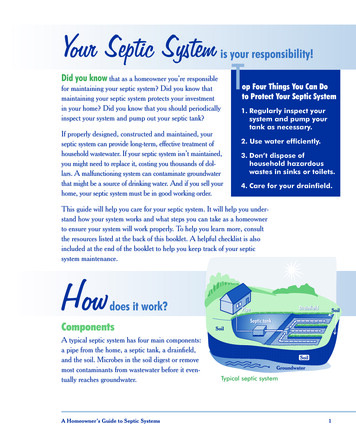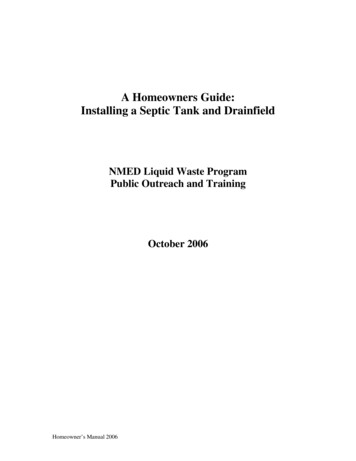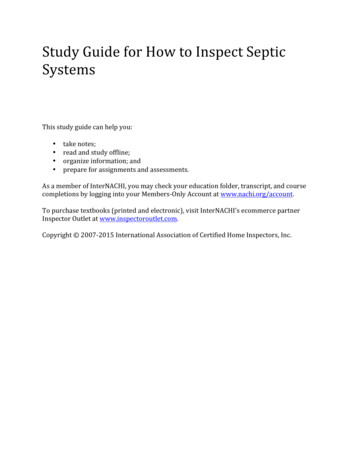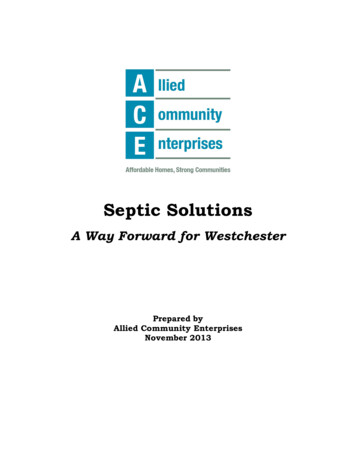
Transcription
Septic SolutionsA Way Forward for WestchesterPrepared byAllied Community EnterprisesNovember 2013
Table of ContentsAbout ACE . 1ACE Septic Solutions Project 2Introduction 2Wastewater Treatment Systems: An Overview 2 Individual Conventional Septic Systems . 2 Figure 1. Residential Conventional Septic System . 3 “Big Pipe” Central Sewer Treatment Plants (CTP) . 3 Peach Lake CTP Case Example . . 4 Decentralized Wastewater Treatment Systems (DWTS) . 5 DWTS Enhanced Treatment Unit (ETU) . 5 Putnam County ETU Case Example . 6 Skaneateles Lake ETU Case Example . 6 Small Community Cluster System (SCCS) . 7 Hillsdale SCCS Case Example . 7 Figure 2. Hillsdale, NY DWTS SCCS 7 Blacksburg, VA SCCS Case Example 8Waste Treatment Systems Cost Comparison . 8 Table 1. Average Cost Comparison Per Residential Connection . 8DWTS in Westchester . 9 Commercial Needs . 9 Economic Benefits of DWTS . 10 Figure 3. Decentralized ETUs: Orenco AdvanTex with Sand Filter . 10 Figure 4. Decentralized ETUs: Premiere Tech ETU Textile Peat Filter 11Funding is Available . 11Moving Forward . 12Resources . 13Acknowledgements . 14ii
About ACEAllied Community Enterprises (ACE) is a not-for-profit corporation that works toincrease the supply of diversified affordable housing opportunities for low and middleincome households in Westchester and nearby counties. By identifying obstacles toaffordable housing and community development ACE finds targeted solutions toovercome those obstacles.ACE serves Westchester and Putnam counties in New York State, where the privatemarketplace does not adequately provide affordable housing. The lack of affordablehousing in this region critically impacts the ability of many people to connect withjobs, schooling and healthy living conditions. ACE fulfills its mission by allying withcommunities to develop projects that fit the scale and character of each neighborhood,village and town, reinforcing the quality of the community for all residents. ACEsponsored housing proposals seek to support community investment in daycare,senior services, and physical infrastructure to support stable, affordable housing.Among its current projects, ACE is working to streamline the municipal and regulatoryapproval processes that often stymie smart growth in the creation of sustainablecommunities. ACE strongly endorses the philosophy of smart growth as defined byEmpire State Futures: “Smart growth is sustainable land use andcommunity/economic development.” ACE’s work is also in line with Patterns forProgress’ (a Hudson Valley policy group) September 2013 report that endorses astreamlined approval process and investment in infrastructure.1
ACE Septic Solutions ProjectIn this report, ACE recommends adoption of Decentralized Wastewater TreatmentSystems (DWTS) as a solution to creating affordable housing and quality communitydevelopment in areas of the County that do not have sewers, particularly inside theNew York City Watershed. Many conventional septic systems are old and undersized,and the septic system regulations are based on older treatment technologies. Currentinadequate infrastructure and restrictive septic regulations are obstacles to thedevelopment of affordable housing in Westchester County.Newer, proven on-site septic system technologies that have been used for years inother parts of the country, including New York State, have rarely been used inWestchester. DWTS can allow for the creation of more units in a development byutilizing less land. DWTS also provide solutions for properties with old or failingconventional septic systems. The proposed DWTS meet the same regulatory treatmentstandards as central sewer treatment plants (CTP). To preserve its environment,including water resources, Westchester County must look towards these proven DWTStechnology solutions to treat its wastewater.IntroductionIt is no exaggeration to say that one of humanity’s greatest achievements has beendeveloping hygienic and effective human waste removal systems. These wastewatertreatment systems significantly enhance the ability to develop safe and sustainablehomes as well as communities. Conversely, failing, outdated and undersizedconventional septic systems can be blights to communities. Far too many localcommunities in northern Westchester have fallen into this latter category. In order toaddress affordable housing concerns and help local businesses, Westchester mustutilize newer proven DWTS technologies. It is for this reason that ACE undertook itsSeptic Solutions Project. This report provides contextual background to Westchester’swastewater treatment strategies as well as recommendations for the use of DWTS thatsupport the concept of "Smart Growth".Wastewater Treatment Systems: An OverviewIndividual Conventional Septic Systems:Septic Systems are also known as onsite wastewater treatment systems (OWTS).Septic Systems are the most prevalent wastewater treatment systems in rural andsuburban areas. A typical household septic system consists of a house sewer pipe,septic tank, distribution box and absorption field(s) or a seepage pit. As seen in Figure1, the amount of space required for a conventional septic system absorption fields is2
extensive. The reason for the large space requirement is because most of the treatmentfor conventional septic systems occurs in the ground soil.Figure 1. Residential Conventional Septic SystemThe septic tank holds the household wastes with heavier solids settling to the bottomof the tank. The lighter solids rise to the top of the tank. The liquid discharge (effluent)from the septic tank requires further treatment. A distribution box directs the liquideffluent flow to either an absorption field or a seepage pit. Both of these dispersalareas must be sized appropriately. The seepage pit (while using less land) is usuallynot used in conjunction with sites using well water. The reason is seepage pits aremuch less efficient at treating wastewater than the larger absorption fields. Anycomponent of a conventional septic system can fail if proper maintenance andpreventative care is not followed. Major component failure can even lead tocontamination of groundwater.“Big Pipe” Central Sewer Treatment Plants (CTP):In larger metropolitan areas, the elimination of wastewater was best done with thecreation of central sewers to which households and businesses were hooked upleading to a surface water discharge after treatment. When the surface waters startedshowing visible evidence of sewage pollution, CTP were created. For example, NewYork City (NYC) has a maze of sewers leading to numerous CTP. Many of these sewercollection systems have been in place for well over a hundred years (which is notuncommon in large cities).Under the "Big Pipe" solution, large diameter pipes take everything including solidhuman waste to a large CTP prior to dispersal to surface waters. The most commonsurface water used for dispersal are rivers but sometimes dispersal is to a lake.Engineering firms typically suggest the CTP solution as it is most familiar to them. The3
CTP usually leads to a much larger budget resulting in higher fees for the engineeringcompanies. These larger CTP work well for most densely populated communities. CTPare often too expensive and inappropriate for smaller suburban or rural communitieslike those in northern Westchester County.Peach Lake CTP Case ExamplePeach Lake is a New York community of 440 homes in theTowns of North Salem in Westchester County and Southeast inPutnam County. Peach Lake has a new CTP which serves as auseful CTP case example.The Peach Lake CTP was designed to accommodate up to500,000 gallons per day of wastewater. Current estimates arethat the system processes between 125,000 and 150,000gallons per day. The Peach Lake system has a high price tag of 33.00 million to date. This represents a cost of 72,000 perhousehold served. The initial estimated cost for Peach Lakewas 22.00 million. Large cost over-runs like this are notuncommon with CTP projects. Peach Lake was funded in partby the East-of-Hudson Development Corp, established by theNYC- DEP to pay for remediation projects aimed at improvingwater quality within the NYC watersheds.Even with the partial funding provided by the NYC-DEP, thePeach Lake CTP has created a heavy financial burden onhomeowners in the community. Each household is obligated topay an average annual sewer tax of approximately 1,200.The Peach Lake CTP installation took over two years andcreated significant disruptions, with streets and individualproperties dug up. Each house also had to upgrade theirelectric systems for the installation of grinder pumps which areused to move all wastewater including solids to the CTP.During the first winter (2012), there was insufficientwastewater usage and flow within the system. This caused thecollection pipes to freeze. This can be a common problem withCTP when they are over-designed. Excess capacity results inmuch higher CTP costs to the community they are designed toserve.4
Decentralized Wastewater Treatment Systems (DWTS):An alternative to the individual conventional septic system and to the ‘Big Pipe” CTP isthe DWTS. The concept of decentralized systems makes sense both in cost andsimplicity.The United States Environmental Protection Agency (US-EPA) has encouraged the useof DWTS since 1997. The EPA has been encouraging the use of DWTS even more so inthe past five years due to cost savings, environmental benefits and the flexibility thesesystems provide smaller communities. In August 2012, the EPA produced four newpublications on DWTS: Introduction to DWTS: A Sensible Approach; DWTS Can Be CostEffective and Economical; DWTS Can Be Green and Sustainable; and DWTS Can Protectthe Environment, Public Health and Water Quality. A link to these informativepublications is on the Westchester County Septic Sub-Committee website listed in thisreport's Resources section and at www.epa.gov/owm/septic.DWTS components typically include: wastewater collection via septic tanks for solids;smaller diameter pipes to transport the liquid effluent to the treatment units; highperformance secondary treatment units; and sub-surface dispersal of the treatedeffluent. DWTS can also provide for surface water dispersal and for treated wastewaterre-use.DWTS are located at or near the source of the wastewater. Treated wastewater isusually dispersed subsurface, but as noted above can also be dispersed to surfacewaters. Treatment performance from DWTS can be comparable to large CTP. BothDWTS and CTP can treat wastewater to the highest possible regulatory standardsincluding the removal of excess nutrients like nitrogen and phosphorus.DWTS benefits include: much lower costs versus a CTP; flexible growth with modularexpansion capabilities on an “as needed” basis; less disruption to public roads andinfrastructure during installation; high levels of treatment performance andenvironmental benefits from re-charging groundwater aquifers and from re-usingtreated wastewater.DWTS Enhanced Treatment Unit (ETU):A DWTS Enhanced Treatment Unit (ETU) is the component of the system that providessecondary treatment levels which means treating the effluent to greater than 90%clean. Some ETU can treat to greater than 95% clean. The ETU can be for a singlehousehold or multiple ETU’s can be used in a clustered system for multiplehouseholds and small communities. ETU allow for modular expansion. ETU are mostcommonly used to replace older failing conventional septic systems.5
Putnam County ETU Case ExampleIn the Putnam County Septic Repair Program, the average perresidence cost for the 160 ETU installed between the years2005-2011 was 23,500. The NYC-DEP paid for most of thesesystems as they were failed conventional septic systems andcesspools located within 250' of the drinking water reservoirsfor NYC. Based on the most current pricing today, the averageETU installed cost for a 3-4 bedroom house (all costs included)would be 21,500.Skaneateles Lake ETU Case ExampleIn New York State, the US-EPA and the City of Syracusepartnered on the National Community DecentralizedWastewater Demonstration Project in Skaneateles Lake. TheSkaneateles Lake Pilot Project sought to determine if DWTSETU could help prevent aging and under-sized septic systemsfrom further polluting the lake. The area was chosen becauseof the small lots, poor soils for biological treatment, dry wellswithin 100 feet of the lake and theshallow depth to groundwater or bedrock. All of these sitecharacteristics are typical of difficult properties and found onmany problem septic system properties.The Skaneateles Lake Pilot Program chose pre-engineered,commercially available ETU that would have a small footprint,in-tank treatment and a proven history of performance. Therewere 19 ETU demonstration site installations all located onSkaneateles lakefront properties. These ETU successfullyreplaced failing conventional installed septic systems Theselected ETU had an annual operations & maintenance cost of 300/year and a target system cost of 20,000 includinginstallation. The ETU were installed between 2003-2010. Alink to the 2010 detailed report on the Skaneateles LakeProject can be found at www.onsite-engineering.us.6
Small Community Cluster System (SCCS):SCCS usually consist of septic tanks at each property (residential or commercial) tocapture as much of the solids in wastewater as possible. A STEP (Septic Tank EffluentPump) inside the septic tank sends the remaining untreated liquid effluent via smalldiameter piping to the secondary treatment units which are usually multiple ETU, Recirculating Sand or Gravel Filters or even a Constructed Treated Wetland. The treatedeffluent is usually sent to a subsurface dispersal field. SCCS can also be discharged tosurface waters. SCCS can provide for the opportunity to have treated wastewater reuse where permitted.Hillsdale SCCS Case ExampleThe Town of Hillsdale, NY located in Columbia County is agood case study for a DWTS SCCS. The Hillsdale DWTS is a35,000-gallon per day facility serving 72 parcels within theHamlet of Hillsdale. Wastewater collection is provided by aSTEP (Septic Tank Effluent Pump). The liquid effluent flow isconveyed via small diameter piping ranging in diameter from1.5 to 3 inches to a central location. The central location has alarge settling tank which provides time dosing to the sevencommercial size ETU. These ETU provide secondary levels oftreatment. Final dispersal is sub-surface to adsorption fields.The average cost per residence in Hillsdale was 16,500resulting in an annual cost to the homeowner of 792 per year.Hillsdale received partial funding from a USDA-RUS grantprogram.Figure 2. Hillsdale, NY DWTS SCCSNotes: The treatment units are on the left and pump tank on the rightwhile an operations/maintenance small shed with control panel is in thebackground.7
Blacksburg, VA SCCS Case ExampleIn 2012 the US-EPA published a report on DecentralizedWastewater Management Case Studies, and identified 14 casestudy communities, including towns and counties. The mostsimilar to Westchester’s situation of the 14 communities isBlacksburg, Virginia.Problem: Blacksburg, Virginia, like many growing communities,faced with the challenge of meeting development needs with adecentralized system or extending the existing centralizedsewer system. The town considered factors such as cost,construction related traffic disruptions, floodplain and creekimpacts due to centralized sewer main construction, collectionsystem infiltration/inflow and leakage, treatment effectiveness,and other factors.Solution: The town established a workgroup to evaluatewastewater treatment system alternatives. After careful review,Blacksburg chose to conduct a pilot project to test thefeasibility of a decentralized, clustered system.Results: Selection of the STEP/STEG system has saved thecommunity more than 1.00 million in construction, withoperation and maintenance costs similar to that ofconventional centralized systems. The town’s public worksdepartment conducts annual inspections of each STEP/STEGsystem and pumps the 200 septic tanks as needed. Theprogram estimates that pumping should occur every sevenyears and estimates an average cost of 150 per tank.Waste Treatment Systems Cost ComparisonTable 1. Average Cost Comparison Per Residential ConnectionCTPETUSCCS 72,000 21,500 15,000Note: Estimates are based on 3-4 bedroom residences.Source: Decentralized Advisors.8
DWTS in WestchesterWestchester County’s wastewater treatment strategies have long been influenced bythe fact that the County stores much of New York City’s drinking water in reservoirslocated through-out the County. In addition to land purchase, New York City hasregulatory authority over development in the NYC Watershed area that comprises mostof northern Westchester.In Westchester, larger commercial and municipal wastewater treatment systems arepermitted by the New York State Department of Environmental Conservation (DEC)while the Westchester County Department of Health regulates all residential and manyof the smaller commercial size septic systems. All areas within the New York CityWatershed's are also subject to the NYC-DEP regulations.There are large central sewer collection pipes leading to CTP throughout southernWestchester where there is higher population density. In northern Westchester thereare some “closed system” sewer districts. These closed systems are limited to aspecific, pre-determined number of households that were established when the systemwas specified. Examples of closed systems include Heritage Hills, a senior housingdevelopment in the Town of Somers, and the Bedford Hills Correctional Facility in theTown of Bedford.Construction of new systems and treatment facilities that can accommodate multifamily housing has been prohibitively costly for developers in Westchester. Even repairand upgrade of existing residential and commercial septic systems has been difficultdue to the lack of familiarity with newer proven DWTS technologies.To address the above problems, the Westchester County Board of Legislators formed aSeptic System Sub-committee. The Septic Sub-committee is a regional stakeholdergroup of East-of-Hudson municipalities, city, county and state agencies, andengineering experts. These stakeholders have been working together to learn moreabout DWTS and to better understand how DWTS can be utilized in Westchester andthe East-of-Hudson Watershed.Commercial Needs:The lack of viable septic system solutions affects the economic vitality of northernWestchester’s hamlets and downtown areas. For example, Katonah’s business districthas an active commercial district, with some residential uses, but has numerousunder-sized and failing conventional septic systems. Many of these business ownersmust have their systems pumped on a regular basis with some requiring weeklypump-outs. Frequent pump-outs are prohibitively expensive for business owners.9
Businesses that use a lot of water such as restaurants and hair salons are continuallymonitored by the Westchester County Board of Health for evidence of failing septicsystems such as odor and visible untreated effluent above ground. Restaurants inKatonah have had to limit their business by allowing only a limited number of seatsbecause of a history of septic failures. Failing septic systems cause problems with theproperty owners’ bottom line and can be damaging to the groundwater andenvironment. Westchester business owners would benefit greatly by having the optionto upgrade their old conventional septic systems to new proven DWTS technologies.Economic Benefits of DWTS:Several major factors influenced ACE’s decision to endorse DWTS for new constructionand for repair & upgrade of existing septic systems.First, the modular expansion capability of a DWWTS allows for projects to be phasedin, preserving the character of a community. Second, the lower cost of installing DWTSdue to the smaller size of the pipes and the use of septic tanks to capture solids attheir source. Moving solids is one of the most expensive processes with wastewatertreatment and should be avoided. Third, site disruption is far less with DWTS versus aconventional CTP and lowers the installation cost. Fourth, on-going operating andmaintenance costs are lower, making the DWTS the most affordable and well-suitedfor affordable housing.Figure 3. Decentralized ETUs: Orenco AdvanTex with Sand Filter10
Figure 4. Decentralized ETUs: Premiere Tech ETU Textile Peat Filter.Note: Photos from Skaneateles project showing how the DWTS ETU canfit into small spaces and next to the lake’s drinking water source.Funding is AvailableAs previously noted, NYC-DEP East of Hudson (EOH) funds were used for the PeachLake CTP. There remain unallocated funds from the NYC-DEP EOH that are currentlyavailable for the Towns of Bedford and Somers. Should these two communities notutilize the EOH funds to treat their wastewater, there is the potential to reallocateEOH funds to other Westchester communities. Other funding resources includeWestchester County Housing Implementation Funds (HIF), which can be used forinfrastructure when the project supports affordable housing.In New York State, the Environmental Facilities Corporation (NYS-EFC) is the stateagency responsible for managing and dispersing the US-EPA Clean Water Act fundingfor New York. NYS-EFC has acknowledged they will fund community systems for bothtraditional CTP and for DWT SCCS as long as the community supports their requestwith an engineering report justifying their preference.Another funding source is the USDA-RUS program which provides funding for smallcommunity wastewater treatment systems including DWTS SCCS. The Hillsdale, NYDWTS SCCS was partially funded by USDA-RUS.11
Moving ForwardThe Westchester County Septic Subcommittee (WC-SSC) has been working with theNYS-DEC, the NYC-DEP, and the Westchester Board of Health to provide educationand information about DWTS. ACE has been an active participant in the WC-SSC.Additionally, both ACE and the WC-SSC have become more fully aware of what usesfor DWTS the US-EPA has been encouraging. The US-EPA has recently defined a new'Water Paradigm' with an emphasis on using DWTS even in parts of urban areas tooffload existing CTP growth requirements with a strong focus on treated wastewaterand storm water reuse. See the four US-EPA publications dated August 2012referenced earlier in this report under DWTS and on the WC-SSC website. Thesepublications show how DWTS are green and sustainable by improving water qualityand availability, using energy and land wisely, and responding to growth needs whilepreserving green space. These DWTS benefits also support the goals of New York's'Smart Growth Development' principles that seek to balance economic, environmentaland equity objectives.In September 2012, the NYC-DEP agreed to pilot a DWTS SCCS in the NYC East ofHudson (Croton) Watershed. The allowed DWTS SCCS pilot will only be used toreplace existing failing septic systems capacity; not for the creation of new additionalcapacity. Westchester County’s Department of Health has also acknowledged theirwillingness to support a pilot DWTS SCCS. A community has not yet been selected forthe SCCS pilot. ACE has several possible locations in mind.NYC-DEP already allows individual ETUs as replacement systems for older individualconventional septic systems although their regulations for ETUs are difficult to meet intheir current form.ACE is available to work with communities interested in learning how to use thesignificant benefits of DWTS to develop affordable housing. ACE approachesdeveloping affordable housing in communities using a blend of activities to ensure asustainable community with a vibrant mix of residential, commercial, retail and civicuses.12
ResourcesDecentralized Advisors. Available at www.decentralizedadvisors.com* Bob Eichinger of Decentralized Advisors provided additional resource links forDWWTS including access to the US EPA funded Skaneateles Lake, NY NationalCommunity Decentralized Demonstration Project at http://www.onsiteengineering.us/small community onsite success.htmlU.S. Environmental Protection Agency. SepticSmart. Available csmart.cfmWestchester County Septic Subcommittee. Available on-septic.html*This resource also links to the January 27, 2011Wastewater TechnologiesPresentation which lists over 10 small community case studies in the nation. Italso includes links to other presentations on DWWTS technologies including thesystem installed at Hillsdale, NY.13
AcknowledgementsACE is grateful for the technical advice from Decentralized Advisers Bob Eichinger andEd Barnett. Eichinger and Barnett were very helpful in navigating what systems couldbe piloted, sorting out the sometimes-contradictory information for ACE, thesubcommittee and various municipalities. Additionally, Eichinger and Barnett haveprovided educational presentations to the ACE staff and board, ACE funders, BlueMountain Housing Development Corporation, and the supervisors of Bedford, NorthSalem and Pound Ridge. www.onsite-engineering.us. Thanks also to Althea Arnoldand Cornelia Bowen and Bob Eichinger for editing this report.Finally, and most importantly ACE would like to acknowledge the funding it hasreceived from the Westchester Community Foundation, and the support of its programofficer for this project, Laura Rossi.14
For additional information about how ACEcan help your home, your block or your communitycontact: info@alliedcommunity.org
Septic Systems are the most prevalent wastewater treatment systems in rural and suburban areas. A typical household septic system consists of a house sewer pipe, septic tank, distribution box and absorption field(s) or a seepage pit. As seen in Figure 1, the amount of space required for a conventional septic system absorption fields is


